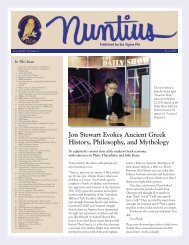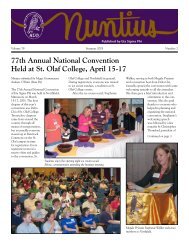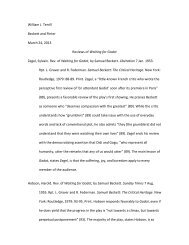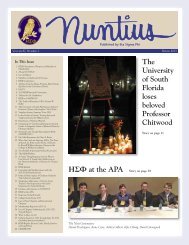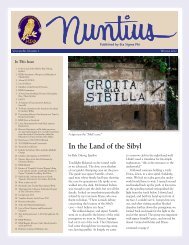Vol. 82, No. 2, Summer 2008 - Monmouth College
Vol. 82, No. 2, Summer 2008 - Monmouth College
Vol. 82, No. 2, Summer 2008 - Monmouth College
You also want an ePaper? Increase the reach of your titles
YUMPU automatically turns print PDFs into web optimized ePapers that Google loves.
Siwa. Yet all attempts for discovering GreatAlexander’s corpse and tomb have failed.Scholars acknowledge, based onbiographical accounts, that Alexanderbecame very ill and died in Babylon,in 323 B.B.C. There, they mummifiedhis remains, in order for his body to betransported back to Aigai, Makedonia inGreece, as had Perdikas (one of Alexander’sDiavdocoi [Greek for “Successors”])planned on intending to do. Furthermore,by mummifying him, Alexanderwas preserved to be a symbol of a god onearth and the people’s connection withthe divine, pantheon realm. MummifyingGreat Alexander was the best way ofpreserving him, as the ultimate symbol ofHellenism for many years to come. On itsway to Aigai, the body was hijacked byPtolemy I and brought to Memphis. Alexanderwas indeed buried in Alexandria(after being transported from Memphis, byPtolemy II Philadelphos-Son of PtolemyI), but his mummified remains disappearedfrom the city, around the late 4 th -early 5 thCentury A.D.Nevertheless, why have there beenso many failed attempts at discoveringAlexander the Great’s final resting place?Throughout all these centuries since thecorpse and tomb’s disappearances, thesecountless expeditions for their discoveryshould have turned up some clues ormissing accounts of their true location.But then other questions arise: What ifarchaeologists are looking in the wrongplaces? What if they are missing pieces toa greater puzzle of truth and amazement? Ibelieve that in order to find the remains ofAlexander, one must first re-examine hisearly life and roots of his family’s lineage,as well as the importance of his last testimonyto his Diavdocoi; (one of which isthat he wished to be buried near his father,in the land where his father’s spirit resides,as well as the land of his ancestors). Thisnew quest for his mummified remainsdoes not begin in the far-East of Babylon(present-day Iraq), nor in Egypt, but here,in the peaceful and lush mountainsideof Gortynia-Arkadia, in Greece. (*<strong>No</strong>te:Gortynia is the name of a region, in thesouth-west of Arkadia. It is considered asthe “heart” of Arkadia).On Monday, July 16, 2007, I came upona very old Byzantine Orthodox Christianicon, when I was visiting various monasteriesof the Peloponnesos. The icon iscalligraphed upon the wall of the mountainsidein which the Arkadian monasteryof ‘Agio~ jIwavnnh~ oJ Provdromo~[Greek for “St. John the Forerunner”]is safely lodged into. It uniquely depictsAlexander the Great dead and in hismummified form; it was like no other Ihave seen before. What truly amazes me isthat the icon is located in a very devout,Byzantine Orthodox Christian monastery.Is it possible? A Byzantine icon depictinga dead pagan, who was revered as a greatking and demi-god? (*<strong>No</strong>te: The originalmonastery was built there around the 9 thCentury A.D. Other accounts claim it wasbuilt in the 12 th Century/13 th Century A.D.Nevertheless, no one is really sure whenthe present monastery began. Accordingto the current monks, some of the archiveswere lost over the years when the monasterywas abandoned, after the HellenicWar for Independence of 1<strong>82</strong>1).This icon portrays Abba St. Sisois (oneof the holy monks of the Early ChristianChurch) visiting the remains of GreatAlexander in the late 4 th -early 5 th CenturyA.D., roughly before Sisois died in429 A.D. Even though there are a fewversions of this portrayal, this particularicon is unique, for as I have analyzed, ituniquely depicts Alexander in his “mummifiedstate.” It shows his remains having acopper-like tone and it is the only one thatexists which portrays him like that, andnot in a skeletal form.There is no historical mention of whenit was “precisely” created or why this iconwas chosen to be depicted. Unfortunatelyuntil now, no one has yet reflected uponthe icon’s importance and how significantit is to the inhabitants of Gortynia-Arkadia(especially to the people of the local villageof Atsicholos [originally Atzi-Cholos]) andto their unique relationship with GreatAlexander. Furthermore, this icon wasthe “smoking gun,” which led me to manyother interesting facts and clues.According to the monks of the ProdromosMonastery, the icon is the workof the famous Byzantine iconographer,Theophanis the Cretan or of his disciples. Ipersonally date the icon circa the mid-16 thCentury (1535-1570 A.D.), when Theophanisand his pupils were still active intheir Cretan School iconography technique.Theophanis was active in his workfrom (1527-1548 A.D.). His pupils continuedhis iconography technique thereafter,for many years. Another possible dateestimation for the icon’s creation, couldbe c. late 16 th Century (1570-1585 A.D.).The estimation of the latter date, is basedon other several iconographs, which werecreated during that time period in theProdromos Monastery.(*<strong>No</strong>te: The Byzantine iconographer,Frangos Katelanos, also created an icondepicting Abba St. Sisois visiting the deadGreat Alexander; c. mid-16 th Century(1548-1558 A.D.). This icon of Katelanos,clearly and distinctively, presents Alexanderthe Great in his “skeletal form,” unlikethe icon of Theophanis. This version of theportrayal is located in the Varlaam Monastery(c. early 16 th Century A.D.), whichis one of the monasteries of the Metevwra[Greek for “high in the heavens”], locatedin Kalambaka, Greece. Katelanos, an iconographerfrom Thebes, was a very prominentapprentice of Theophanis the Cretan.He continued the iconography techniqueof Theophanis, but with his own uniquenessof artistic form, he evolved the Cretanstyle. He is considered to represent a newstyle of Byzantine iconography, known asthe Theban School).The Arkadian monastery whichcontains this icon, is precisely locatednear the ancient city of Gortynos, themost ancient city after Lykosoura. Thelegendary founder of the city was Gortys,a descendant of King Lykaon and heir tothe land around Mt. Lykaion. Also, theriver Lousios passes besides the ancientcity and the myth is that the young Zeusbathed in its frigid waters. Thus, the rivergets its name from the Greek word louvsw,which means “to bathe.” (*<strong>No</strong>te: AncientGortynos is even mentioned by Homerin The Iliad, in which the Gortynians andother Arkadians were led by King Ortynos,during the Trojan War).Furthermore, the city’s ruins liebeneath the shadow of Mt. Lykaion, thereputed birthplace of the Olympian deity,Luvkaio~ Zeuv~. (*<strong>No</strong>te: Even today,the peak still bears its ancient name of49





